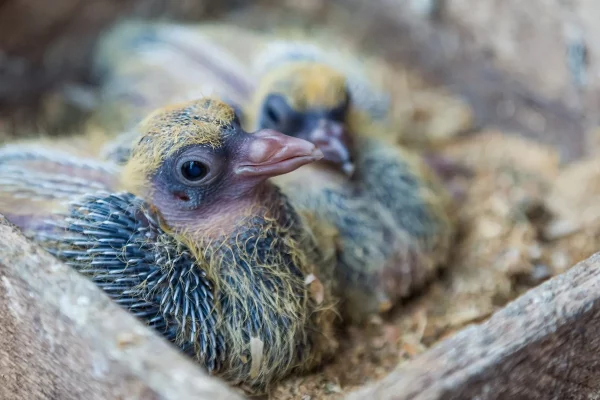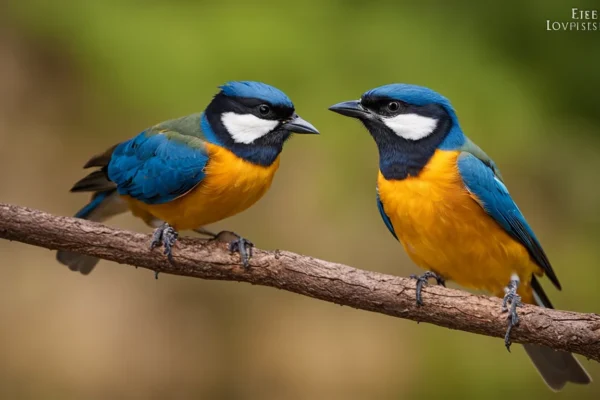What’s the Difference Between a Lovebird and a Parakeet?
Despite their comparable sizes, parakeets and lovebirds have vastly different temperaments, behaviors, loudness, and ways of interacting with humans and other animals.
Parakeets are significantly longer in size, but lovebirds are heavier and have broader beaks. Parakeets have a more lively personalities than lovebirds, who are more territorial. Both may make a lot of noise, but lovebirds are by far the loudest of the two.
In the rest of this blog, I’ll go over the distinctions between the two birds so you have a better grasp of them.
Physical Differences:
Parakeets, also known as budgies or budgerigars, are the lighter of the two parrots, weighing between 30 and 40 grams, while lovebirds weigh between 40 and 60 grams. Lovebirds are normally 13 – 17cm in length from tail to head, while parakeets are 18 – 21cm.
Parakeets have a longer wingspan of around 30cm, whereas lovebirds have a wingspan of around 24cm. While parakeets are technically larger (due to their longer tails), lovebirds are the heavier of the two, weighing more and having a slightly larger frame.
Lovebirds have a longer lifespan in captivity, ranging from 10 to 15 years, whereas parakeets have a shorter lifespan, ranging from 5 to 8 years.
Parakeets come in a range of colors, with yellow or white as the base color. Yellow-based parakeets may be any color from yellow to green, whereas white-based parakeets can be any color from white to blue.
Lovebirds appear in a range of colors, including white, blue, and green, with the most frequent lovebirds being green.
Lovebirds have a bigger beak as well, and they’re renowned for being more aggressive with it, which I’ll go over in more depth below.
How Do Lovebirds Interact With Other Birds Differently Than Parakeets?
Female lovebirds are territorial around their nests and more violent than males, so that’s one difference.
Parakeets are more sociable and may engage with smaller parrots like cockatiels and parrotlets, unlike lovebirds, which attack guests.
Parakeets and lovebirds are monogamous birds that need company, whether from another species or a trusted owner.
How noisy are both:
Both love birds and parakeets aren’t particularly quiet in terms of noise levels, especially early in the morning when other birds are singing or chirping outside.
However, depending on their mood and time of day, each bird makes different noises. Even among other pet birds, parakeets are the quietest, and due to their social nature, if another bird or person is present, they will generally produce lighter and faster chirps in an attempt to strike up a conversation.
That’s their more subdued and quieter tone, but the volume can quickly rise and fall depending on their mood. These birds can reach much higher volumes when excited or scared, reaching up to 65 decibels.
Lovebirds, on the other hand, are much noisier, with a volume of around 83 decibels. Their squawks are also louder, and they can be heard through multiple walls.
Where Do Lovebirds And Parakeets Live In The Wild?
Lovebirds and parakeets reside on separate continents but have comparable natural environments.
Australian parakeets live in groups of three or thousands at exceptional events like Alice Springs. In that instance, thousands of parakeets all wanted to divebomb a huge water hole.
Besides that, parakeets communicate information like where to obtain food, water, etc.
In southwest Africa, lovebirds fly in flocks of two to six, depending on the season. Their aggressiveness and territoriality make them less sociable than parakeets, therefore they seldom communicate information across flocks.
Both parrots can be dominant, however parakeets are more tolerant of their social circle, whereas lovebirds may compel someone to take blood if they don’t like them.
Is it necessary to purchase parakeets or lovebirds in pairs?
Neither bird requires a companion as long as their owner is willing to devote enough time to develop a bond.
Parakeets may take a little longer to bond with because they like to socialize and won’t be as happy if they don’t get enough of it. When you first get a parakeet, it’s recommended that you spend 4–5 hours bonding with them.
Once the bond has been formed, you will still need to pay attention to the little bird to keep it happy, but not as much as you did when the bond was being formed. Lovebirds are more reserved in this regard, making them a little more difficult to tame (especially the more aggressive females).
The bonding strategy is the same for lovebirds, though their less social temperament makes it a little more difficult to bond with them.
It is easier to get a pair of parakeets or a pair of lovebirds to keep each other company in both cases, especially if you have a busy lifestyle, but it is not a requirement. Either parrot can be purchased as a single pet if you have the time and patience to maintain their happiness by socializing with them every day.
Conclusion:
The following are the main differences between parakeets and lovebirds:
- Parakeets are longer, but lovebirds are heavier.
- Lovebirds have larger beaks than parakeets.
- Lovebirds are much louder than parakeets.
- Parakeets are more social; Lovebirds are more territorial and aggressive.
- Parakeets have longer wingspans.
- Lovebirds have a longer lifespan than parakeets.
Both parrots are great pets and easy to care for, but if you don’t want a loud animal in your home or have neighbors who might be annoyed by your parakeet’s or lovebird’s squawking, do some research before buying either.
Frequently Asked Questions (FAQs)
Is it True That Lovebirds Make Good Pets?
A lovebird could be the perfect pet for you if you enjoy birds. You must, however, be prepared to set aside time to bond with one and listen to their higher-pitched screeches.
A lovebird is easier to train, and it is also easier to communicate with and understand because it is a more sociable parrot.
A lovebird will also come in a variety of vibrant colors, so you won’t be afraid to have one in your living room.
Lovebirds can survive on a variety of grains and fresh fruits in their diet. Wild plants and various vegetables are also good additions to a lovebird’s diet.
Can Lovebirds and Parakeets live with each other?
Lovebirds and parakeets do not get along well in the same cage unless you acquire them when they are quite young and maintain them in different cages at first.
A lovebird is naturally more aggressive and powerful than a parakeet. It is also fiercely territorial. So, a love bird with a stronger beak and body might physically injure the parakeet.
However, if you buy these two birds when they are very young and maintain them in close proximity but separate cages for at least a year, you may be able to properly educate them to live together. This manner, they’ll gradually connect with one other, and you’ll be able to leave them in the same cage without worrying about your parakeet’s safety.
Can Lovebirds and Parakeets Mate with Each Other?
Some people believe that parakeets and lovebirds may mate, but this is untrue, according to animal specialists. Because they are from two different species, the eggs they lay will not survive, and there will be no fertilization because male birds from different species cannot mate with female birds.
Even among all the numerous lovebird species, finding a couple capable of producing viable eggs is difficult. Because the DNA isn’t compatible, the consequence is likely to be an infertile egg.
Are Lovebirds a Lot of Work?
Lovebirds are a low-maintenance bird compared to other larger bird pets. You don’t anticipate spending a lot of money on one. However, you’ll need to purchase your pet a robust cage and prepare a suitable pellet-based feed for it.
It’s worth mentioning that a lovebird is used to being in confinement. So, depending on its age, you may need to devote extra time and resources to preparing your new bird to thrive in your house.






